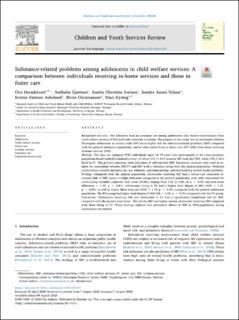| dc.description.abstract | Background and aims
The literature base on substance use among adolescents who receive interventions from child welfare services (CWS) in Nordic countries is limited. The purpose of this study was to investigate whether Norwegian adolescents in contact with CWS are at higher risk for substance-related problems (SRP) compared with the general adolescent population, and to what extent those in foster care (FC) differ from those receiving in-home services (IHS).
Methods
The data set comprise 9785 individuals aged 16–19 years who participated in the cross-sectional, population-based youth@hordaland-survey, of whom 141 (1.4%) received IHS from the CWS, while 155 (1.6%) lived in FC. The primary outcomes were indicators of self-reported SRP. Regression analyses were used to explore the association between IHS/FC and SRP with a reference group from the general population. Potential confounding variables included age, sex, ethnicity, and internalizing- and externalizing mental health problems.
Findings
Compared with the general population, adolescents receiving IHS had a robust and consistent increased odds of SRP across multiple indicators compared to the general population, even after adjustment for confounding variables (adjusted odds ratios [AORs] ranging from 1.81 to 3.04, all p < 0.05; adjusted mean difference = 1.49, p < 0.01). Adolescents living in FC had a higher total degree of SRP (AOR = 1.51, p < 0.05), as well as higher illicit drug use (AOR = 1.75, p < 0.05), compared with the general adolescent population. The IHS-group had higher total degree of SRP (OR = 2.08, p < 0.01) compared with the FC-group.
Conclusions
Adolescents receiving IHS and adolescents in FC had a significantly heightened risk for SRP, compared with the general population. The risk for SRP was higher among adolescents receiving IHS compared with those living in FC. These findings indicate that prevention efforts of SRP in CWS-populations during adolescence are needed. | en_US |

